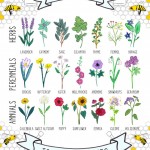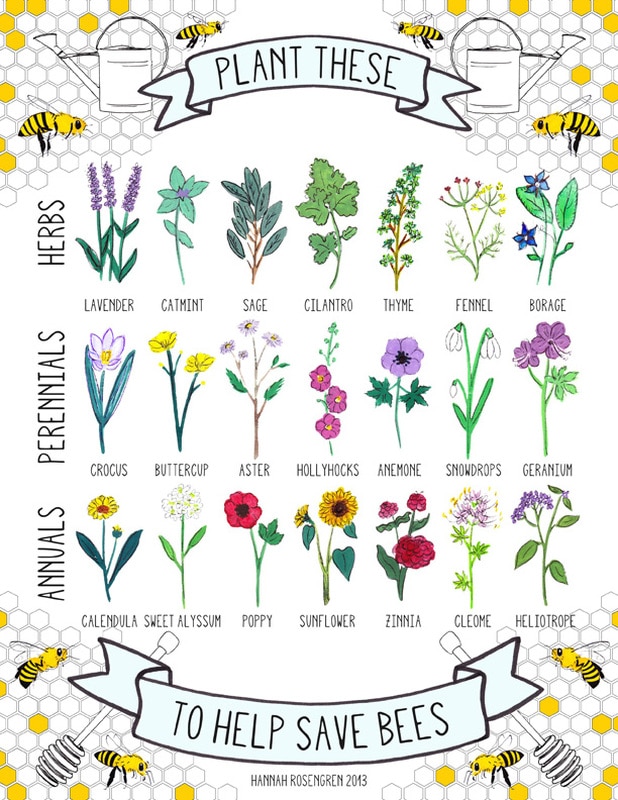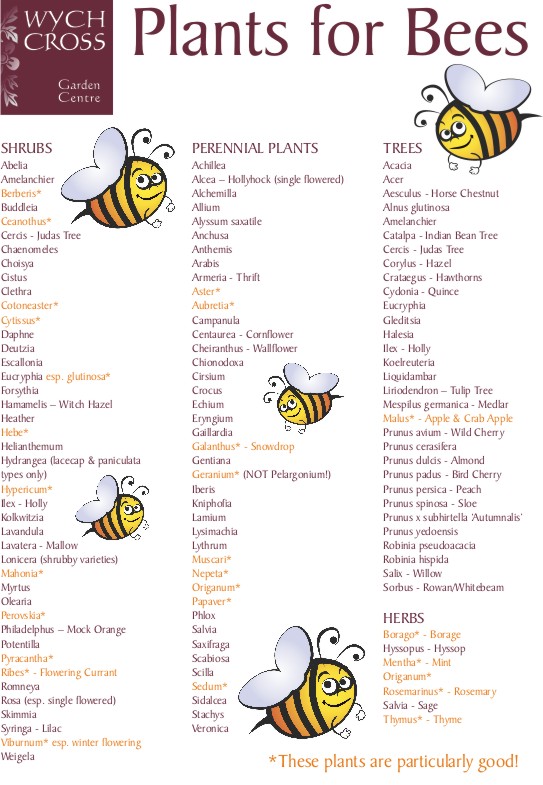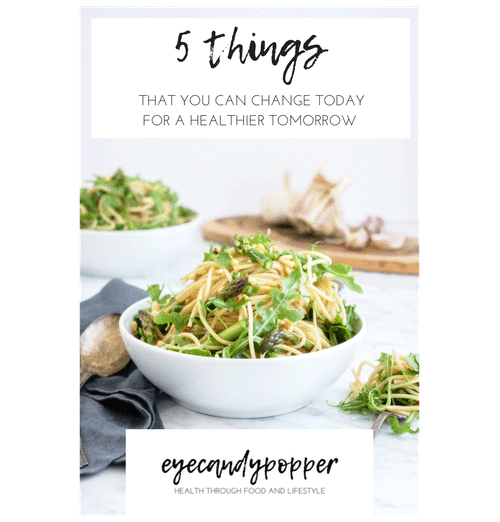Looking for some gardening projects to do this weekend? Why not keep the bees in mind when planting? With the dramatic death of bees in the recent years due to pesticides, they need all the help they can get, and considering that 90% of our food and the trees that produce oxygen can’t grow without bees, they need all the help we can get too 😉 Here is how to create a bee friendly garden!
I found this great article from the David Suzuki Foundation, and thought I’d share some excerpts, for your reading pleasure, along with some cool pictures. Click in the link for the full article.
Save the Bees! by Hannah Rosengren http://www.hannahrosengren.com/help-save-bees.html
Some people think nature is “out there”, in a national park or other designated wilderness area. But bees, our most important pollinators, love to live in urban settings where there are short flight paths, and a variety of different plants and flowers to sample. In fact, bees are more likely to thrive in your backyard, community or patio garden, and on mixed farms than on acres devoted to single crops.
Create a welcome place for bees
Creating hospitable homes for beneficial insects in your garden means they are less likely to move into your house.
You’ll triple the yield of fruit and veggies in your garden — no more lumpy strawberries or shrunken squash!
Even what seems like a small contribution — just a tiny flower pot or patch — can provide valuable pollinator habitat.
Attract bees to your backyard or garden
Build a bee house
House walls: an empty milk carton (waterproof) with the spout cut off — leave the bottom intact — or a box about that size made of wood scraps (not cedar).
Paint a wooden house a bright colour with exterior zero- or low-VOC (volatile organic compounds) paint. At first, the bees will fly around taking mental “snapshots” of their potential new home, but they’ll soon learn to make a bee-line to their new abode. If you plan to make more than one bee house, be sure they’re different colours.
Fill the box with layered stacks of brown paper nest tubes, which you can buy at a garden store. Cut the tubes to six inches (15.75 cm) long, closing the end with tape or a staple, or fold them in half. Commercial nest tubes are 5/16 of an inch (.79 cm) in diameter, the exact size of an HB pencil. Make your own by rolling a piece of brown paper around a pencil, then pinch off the end and seal it with tape.
Hang the house somewhere out of the rain, facing south or east, at eye level, once the temperature outside has warmed to 12-14º C (54-57º F).
Dig down below your garden soil adjacent to your bee house until you expose the clay layer, or keep a bowl of moist clay near your bee house for the masons to use as construction material.
It may take a full season for the bees to find your house. If you don’t have any luck attracting locals, you can also purchase mason bees from a garden store or local bee keeper.
Provide nutritious bee food
Bees eat two things: nectar (loaded with sugar, it’s a bee’s main source of energy) and pollen (which provides proteins and fats).
Choose a variety of plants that flower at different times so there’s always a snack available for when bees are out and about. (Rule: native plants attract native bees and exotic plants attract honeybees.)
Flowers bred to please the human eye (for things like size and complexity) are sometimes sterile and of little use to pollinators. Native plants or heirloom varieties are best.
Bees have good colour vision — that’s why flowers are so showy! They especially like blue, purple, violet, white and yellow. Plant flowers of a single species in clumps about four feet in diameter instead of in scatterings so bees are more likely to find them.
Bee species all have different tongue lengths — adaptations to different flowers, so a variety of flower shapes will benefit a diversity of bees.
These plants, organized by when they bloom, are just a few of the species native to Canada that attract bees:
| Early | Mid-season | Late |
| Blueberry | Blackberry | Aster (perennial) |
| Cotoneaster | Cat mint | Beggar’s tricks |
| Crabapple | Catnip | Borage |
| Cranberry | Chives | Coneflower |
| Crocus | Dahlia | Cornflower |
| Foxglove | Hyssop | Cosmos |
| Heliotrope | Lavender | Goldenrod |
| Hazelnut | Raspberry | Pumpkin |
| Heather | Sunflower | Sedum |
| Primrose | Yarrow | Squash |
| Willow |
Make a bee bath
Bees and other beneficial insects — ladybugs, butterflies, and predatory wasps — all need fresh water to drink but most can’t land in a conventional bird bath without crashing. “They’re like tanks with wings,” says bee master Brian Campbell. “They need islands in the water to touch down on.”
Line a shallow bowl or plate with rocks.
Add water, but leave the rocks as dry islands to serve as landing pads.
Place the bath at the ground level in your garden. (Put it near “problem plants” — those that get aphids, for example — and the beneficial insects that come to drink will look after them.)
Refresh the water daily, adding just enough to evaporate by day’s end.
Photo copyrights Wych Cross Garden Centre





This is such a brilliant and informative post! I’m actually going to send it to some of my family members!
Saving bees and promoting their good health is so important to the ecosystem, and all those plants are so great too! Lavender and cilantro?? Awesome!!
I’m so glad you like it and will share it! The more people know about this, the better! It’ll be good for everyone, and pretty to look at! 🙂
Wonderful article about a subject close to my heart. Thank you, ECP!
You’re welcome! 🙂
Love your post!!! I have a vegetable garden and I always try to have lots of flowers for the bees. Now i have a list to refer to. Bees love dandelion too in the spring, it’s one the first flower around. I had a ton of bees in my yard this year because of the bad weather, it was the only flowers available. Sometimes it doesn’t cost anything to be good 😉 Thanks for the list, I’m going to plant a lot more!
Yay! Good point about the dandelion in the spring. There will be a lot of happy bees in your area! 🙂
Love the post! Bees are so important, and its great to find a place with all the information you need in one place! I linked this page to my blog. Thanks for putting out this information!
My pleasure!
Hi there! This is a great post – while I’m so glad you’re advocating for the bees it’s a bummer that my illustration isn’t credited (Plant These to Help Save Bees) – through no fault of yours this version has circled the web without credit but I keep seeing it pop up on Pinterest and linking back to here, so if you could add my name that would be wonderful. Or if you’d like, I have the version with my name on my website (http://www.hannahrosengren.com/help-save-bees.html) if you’d like to repost that please feel free (I also have a sister illustration for our monarch friends if you’re interested). Thanks so much!!
Hello! First of all, let me apologize, not that it’s any excuse, but when I wrote the post I was in my beginning stages of blogging and knew nothing about online copyrights! I will change the picture right away and give you credit of course! I noticed that you have different versions in other languages, ss an apology, can I translate it in French for you? (I’m a translator)
Oh my gosh, no worries! The credit was missing on one version and that’s just what happened to take off online so it’s certainly not your fault! Thank you so much for replacing it- much appreciated. While you absolutely shouldn’t feel like you have to, if you do want to and have the time, I would LOVE to be able to make a French version!!
My pleasure! I’m pretty busy in the coming weeks, but will try to fit this in 😉